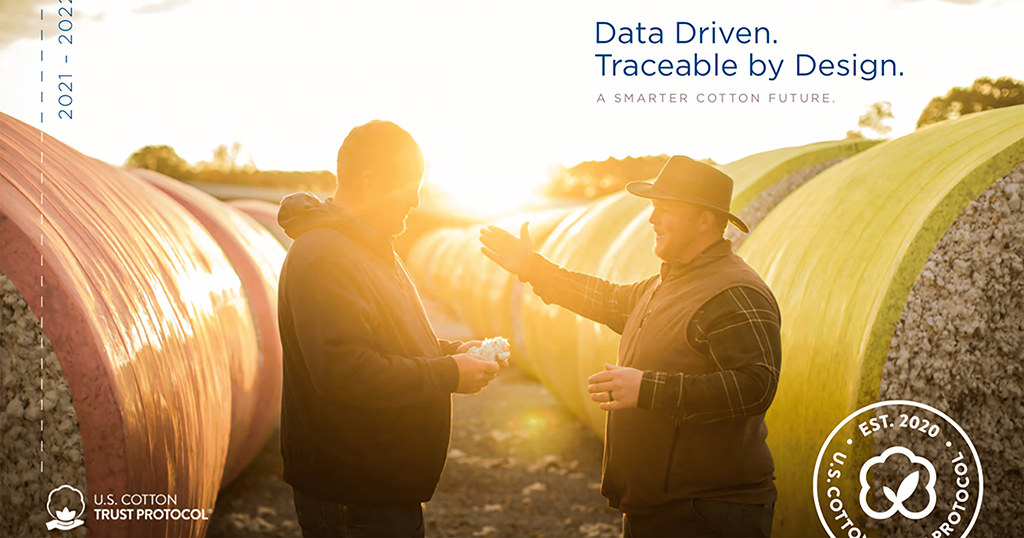The U.S. Cotton Trust Protocol has published its second annual report, detailing the results for the 2021-22 period (August 1st, 2021-July 31st, 2022). The farm-level, science-based sustainability program today reports significant improvements in the sustainability metrics measured; an increase in membership across the value chain; the completion of nine successful pilots; and its growing international recognition by independent and government bodies.

Growing Sustainable Results
In the 2021-22 period the Trust Protocol was able to provide farm-level data reporting showing significant improvements with grower members having demonstrated tangible results across six key metrics. Using peer-to-peer data sharing and aggregated sustainability data provided by the Trust Protocol, its 2021-22 grower members have recorded1:
• a 13% increase in land use efficiency and a 14% increase in water use efficiency;
• a 25% reduction in energy use;
• a 21% reduction in greenhouse gas emissions;
• a 78% reduction in soil loss, and
• positive Soil Conservation Index for 70% of growers.
Membership Growth Across the Value Chain
Membership across the program has grown solidly both domestically in the U.S. and internationally.
• Enrolled areas of U.S. cotton production have doubled since the program’s pilot year to 1.1 million acres (445k ha).
o All 17 U.S. cotton-producing states are now represented
• Mill-and-manufacturer membership has increased significantly
o counts 820 companies from 30 countries
o An increase of >50% in past year
• Total number of brand-and-retail members has grown to 40
o Members include global brand and retailer giants such as Ralph Lauren, J. Crew, Tesco, Levi Strauss & Co., GAP and Old Navy.
Scaling Solutions
The Trust Protocol has been piloting, testing and scaling the technology solutions that record and track the movement of U.S. Cotton and Protocol Cotton through brand and retailer member’s supply chains to their finished products. This allows for tracking cotton through complex supply chains in a way that has not been possible at scale before.
• Nine completed pilots involving global brands and retailers with nearly 150 mills
• A further 15 pilots are confirmed to be initiated with 125 additional mills
International Recognition
In 2022 the Trust Protocol received international recognition from two major evaluation bodies.
• In May 2022 the Trust Protocol was approved by Siegelklarheit
o An initiative of the German federal government Siegelklarheit (‘seal clarity’) is a transparent, independent and comprehensive evaluation system that informs consumers about credible seals to allow them to make more sustainable purchasing decisions.
• The Trust Protocol was accepted as an ISEAL Community Member in June 2022
o ISEAL Community Membership comes just 18 months after the program’s launch, following a rigorous and meticulous approval process.
o ISEAL supports ambitious sustainability systems and their partners to tackle the world’s most pressing challenges by, among other things, defining credible practice for sustainability systems based on emerging global consensus.

Commenting on the results, Dr. Gary Adams, President of the U.S. Cotton Trust Protocol, said:
“These results are excellent, and even more so given the challenges of the past year– from increased scrutiny brought by the changing regulatory landscape, to U.S. cotton growers faced with rising production costs and weather extremes. The past year has been one of perseverance, dedication and commitment. That has meant focusing on foundational growth and making thoughtful, innovative decisions.
To continue this growth and ensure the program’s success we need to maintain our unwavering commitment to, and support of, our growers as they work towards continuously improving against our six core environmental metrics. Maintaining a focus on innovation and implementation of the latest technologies will also be a key tool in helping them to improve our future environmental footprint.”
Adams continued: The results speak for themselves: in the impressive progress made by our growers on key sustainability metrics; and in how positively the supply chain has responded, demonstrated by the increase in the number of growers, mills, manufacturers, brands and retailers who are active members of the program.
As we continue to increase the number of growers participating in the Trust Protocol, we also expect that future environmental performance against our targets may change. Ultimately to have the greatest impact requires both the broadest participation and the best environmental performance. We strive for both, but we also want to be transparent about our expectations for the future with our partners as we grow.”